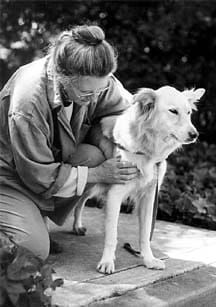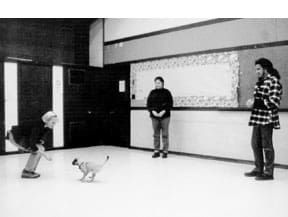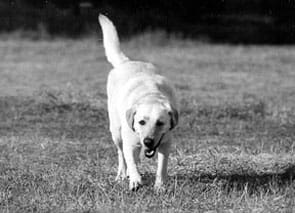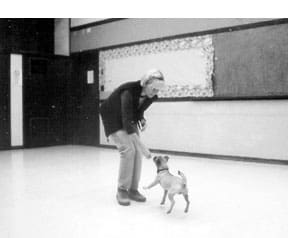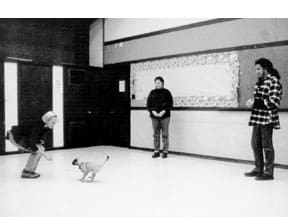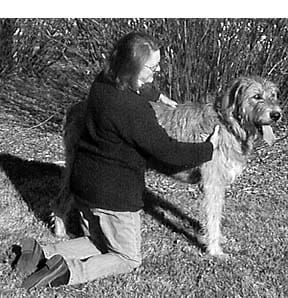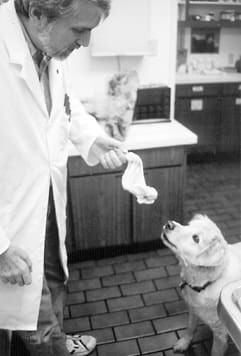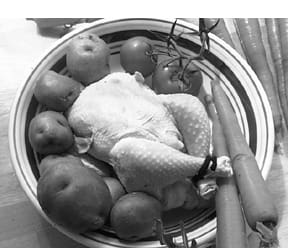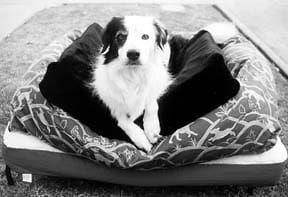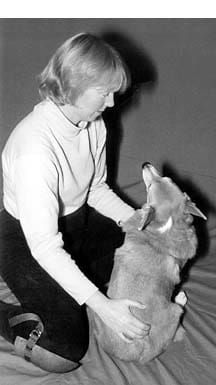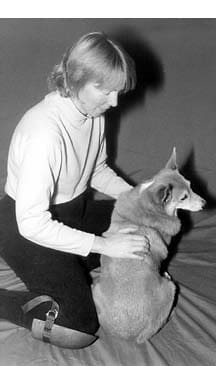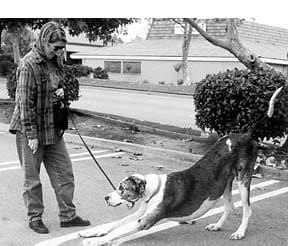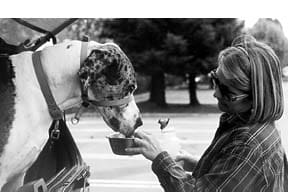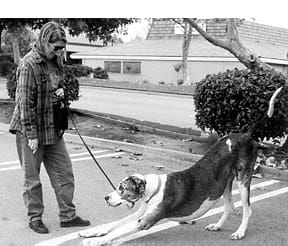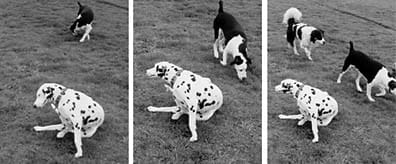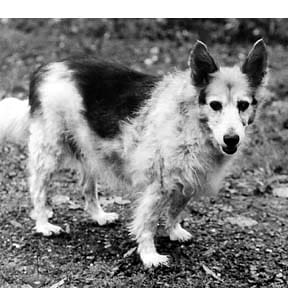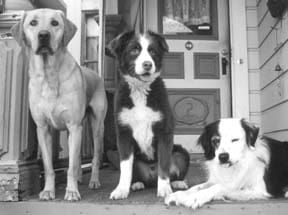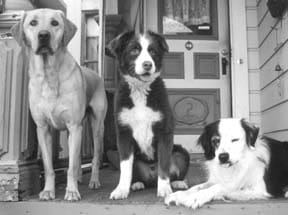The second attempt to find a home for Suki, a five-month-old Akita, had met with failure. The well-intended, very loving couple were in tears as they brought her back to the Akita Rescue Family in Lewisberry, Pennsylvania. The normal expectations they had of her falling into place as the puppy of their “pack” had been quickly dashed. Suki had relentlessly attacked Lika, their 13-year-old spayed Chow mix, so viscously that the formerly “alpha” female became fearful and intimidated. She spent the last days of Suki’s short stay in a hiding place under the stairwell.
The woman who ran the rescue center from her home had an in-depth history with dogs. Her immediate family of 13 included dogs in a variety of shapes and sizes, but she adored Akitas. Over a 10-year period she trained them, showed in obedience, coached problem behaviors, and had researched their predisposition to certain health imbalances; she knew this breed well.
However, even after three years of experience in rescue work, she was completely baffled by this puppy. Without provocation, Suki would suddenly attack other dogs regardless of their gender, age, size, or social position in the pack. She was a perfect sweetheart with adult humans, but having her around children was out of the question.
Nearly at her wits’ end, the rescue volunteer asked for my help as an animal communicator and intuitive healer. She asked me to “tell” Suki that if she persisted in her aggressive behavior, “it will probably result in her death.”
Taking a deep breath, I bent my head in prayer. I knew that the hoped-for outcome – the desired intention – was out of my hands. But I prayed that things would work out for Suki.
About two months later, on an evening when I was in my office later than usual, the phone rang. It was the rescue volunteer calling with a report on Suki. The Akita youngster had just been placed in a new home, one with another dog and children. As I listened to the heartening changes that Suki had made, I closed my eyes, smiled, and nodded my head in gratitude. Suki had developed an attitude of graciousness with other dogs and overcame her need to challenge their pack rank. She had developed her ability to be more present in the moment and respond accordingly in each individual situation, rather than reacting from some “program” from her past.
Teamwork really helped this case along. Suki is an exceptional dog possessing a focused mind and a deep desire to act in a “correct” manner, one worthy of her high level of self-esteem. Her caretaker had the ability to put the insights and suggestions from our session into action immediately. My role was to provide prayerful intent, which, like a radio, fine tunes and amplifies the link between the good intention of a person, the challenges faced by an animal she loves, and the mystery of the Divine.
What qualifies as prayer?
Intention means fixing the mind to a particular outcome. Prayer can be offering devout, sincere praise or thanks to God (or any vision of a higher power), or making a petition or request for something in a humble manner. These two words have only subtle distinctions and seem to stem from the same core. In my mind, the intentions of our thoughts can be considered prayers. Most of us want “what’s best” for our animal companions, just as we want our human loved ones to be safe from harm and illness. Directing our thoughts of safety and wellness toward others is what’s known as intercessory prayer, and there have been a number of scientific, double-blind studies confirming that this kind of prayer can have power.
One of the most frequently reported studies, published in 1988, showed that heart patients who were prayed for had fewer complications than patients who did not receive prayers, even though the patients in the study did not know which group they were in (the prayer or no-prayer group).
Mental energies
A more recent report, published in the December 15, 1999 Western Journal of Medicine, confirmed the power of intercessory prayer. The study, conducted at the California Pacific Medical Center’s Complementary Medicine Research Institute, focused on 40 patients with advanced AIDS symptoms. For each patient, the organizers of the study recruited “volunteer healers,” people who would focus their mental energies on a single patient’s health and well being for one hour a day, six days a week, for 10 weeks. The healers were given only each patient’s first name and photograph, and the sessions were organized on a rotating basis with different patients being treated by a different healer each week.
The volunteer healers, who had not met the patients receiving their treatments, worked long distance from various locations throughout the United States and Canada. Between themselves they had an average of 17 years experience and represented eight different healing traditions including Christian, Jewish, Buddhist, Native American, and Shamanic, as well as graduates of bioenergetic and meditative healing schools. Following the same rigorous criteria for double-blind studies established by the FDA for the approval of new drugs, neither the patients nor their physicians knew who would receive the distant healing. Since this method removes the possibility of the outcome being influenced by a belief or intention, doctors conducting research in this manner work under the assumption that the information collected provides more accurate results.
As this study drew toward its close the data showed that the patients who received long distance healing experienced fewer and less severe illnesses, a decreased need for hospital visits and had longer periods of improved mental outlook and emotional disposition. The conclusion establishes that healing through intention produced documented, substantial improvements in patients with advanced AIDS symptoms.
The science of prayer
At a 1998 course on “Spirituality and Healing in Medicine,” David Larson, of the National Institute for Healthcare Research, called the power of faith the “forgotten factor,” and says that it has been “neglected and mishandled” because of scientists’ attitudes toward religion. He also joked that such research can be called “the anti-tenure factor,” because if you study it, “you can actually go backward” in your career.
But the fact that the conference, sponsored by the Mind/Body Institute and the Institute of Religion at the Texas Medical Center, drew some 700 medical professionals to learn about the healing practices of several faiths, may be a sign that even scientists are opening their minds to the practice of prayer. William Tiller, Ph.D., a physics professor at Stanford University, in Palo Alto, California, might seem at first glance to be an unlikely advocate of the power of something as obscure as prayer. However, his studies of quantum physics have led him to believe that one can explain consciousness mathematically, and that the power of thought can have a measureable effect on physical reality.
In his book, Science and Human Transfomation: Subtle Energies, Intentionality, and Consciousness, Dr. Tiller describes his studies of the fundamental subatomic building blocks of our universe and the processes which involve the transference or transformation of energy between these particles in an atomic or molecular state. Professor Tiller says that he has seen evidence which draws his attention toward the elusive link between thought and matter. “I think that consciousness will eventually be discovered to be a quality of the universe that has the capability of generating radiations which eventually beget matter,” Tiller says. Intention, he says, is “a desire to imprint from the level of Spirit.” Dr. Tiller has reported that he is convinced that even DNA (the genetic codes that make us who we are and instruct each cell in our body to perform their unique functions) are susceptible to intention.
Intercessory prayer
I have found that even though my clients usually have a desired result in mind when they ask for my help with an animal, I do not focus on any specific outcome. Instead, I pray that the situation be resolved in a way which provides the highest good for all concerned. In his book Healing Words: The Power of Prayer and the Practice of Medicine, author and medical doctor Larry Dossey calls this type of request an “open-ended prayer,” and claims that these open-ended prayers are the most powerful of all.
In Healing Words, Dr. Dossey describes a simple study of seeds that had been soaked in salt water before planting. This practice is harmful to most plants. The seeds were then divided into three groups. The first group received no prayers whatsoever. The second group received prayers of a very specific nature, with predetermined outcomes offered for them. These intentions directed the seedlings to reject the salt water, grow sound and plump, and encouraged them to grow to a certain height.
The third group received an open-ended prayer, to wit: “We surrender these seeds to the goodness of the universe, so they may manifest their highest potential and whatever is in the highest good.”
Dossey reports that the seeds that received no prayers died. The ones that received prayers pinpointing specific requirements and outcomes did much better; most sprouted and actually grew a little bit. However, the seeds that simply had open-ended, good intentions wished for them surpassed the others. Comparatively, those that received the attachment-focused prayers grew only a fraction when compared to the seeds that had been tenderly and lovingly surrendered to their highest good in the universe.
These results demonstrate the importance of being unattached to the outcome occurring in a specific way. Letting go of these ideas helps us build more trust in the process of life. This also allows the unpredictable synchronicity of life to provide us with an outcome that often surpasses our plans.
Emotional detachment
Acquiring the ability for being detached is vital when our intentions are focused on the well being of another we love dearly. Caring for and about an ill or emotionally unwell animal companion can be upsetting. The intense emotional waves rising within us are an integral part of us which must be accepted and honored in order to heal. But as physical beings, we must learn the value of expressing these powerful shifts appropriately, or they can begin directing our thoughts and actions.
When contacted to help with situations that can involve behavior, communication, or health imbalances, I stress that each individual (person or animal) chooses their own path to wellness. I cannot predict what their needed time frame will be. Some move forward one step at a time over a period of weeks or months; others benefit from annual check-ins. These situations produce the best results when periodic infusions of focused healing are provided. Others achieve such dramatic improvements that their stories of recovery are often described as miraculous.
Two years ago when Brightdot’s caretaker asked for my assistance, she was considering euthanasia for the older female Spaniel mix. Brightdot had endured the results of a stroke for several months. Watching her stumble when she walked, having difficulty getting up, and shifting into periods of mental confusion were sad indications that her quality of life was decreasing. Simply supporting the weight of her medium-large frame was strenuous for the Spaniel, and her guardian, who had cared for Brightdot since puppyhood, felt limited in being able to help lift or carry her.
I believe that each time I connect with an animal the work is Divinely guided. Every situation is unique in how I am led to help resolve the existing challenges for the highest good of all concerned. In this situation, Brightdot clearly had an underlying zest for life which aided her in completely transforming her situation. Within a few weeks her caretaker told me, “After your session with her all her problems just went away.”
Trust the outcome
What happens when prayers appear to go unanswered? I think that when the intentions of our prayers – important ones – are passed over, the answers we seek are still within us, not outside of us. Each individual is a unique blend of his or her past, present and hopes for the future, as well as physical, emotional, mental and spiritual qualities. Our attempts at communicating with the Divine can bring us moments of crystal clarity where we know, as if by instinct, what our Higher Self is directing us to do, while at other times we wander without direction or intent. What we believe, choose to turn away from, or are drawn toward is a significant part of our personal growth and development. Like Dorothy in The Wizard of Oz, we carry with us the ability to return to our Source whenever we want. There are numerous religious and spiritually based practices which provide an opportunity for each of us to discover our own path.
The years have given me an approach for coping with the sense of disappointment that I used to experience when my carefully offered prayers rise like wisps of smoke, never to be heard from again. Although some insight can be gained from briefly asking why things turned out a certain way, little is gained by digging deeply into this question. Of course, each individual chooses his own path to wellness, even when his instinctive need is different from our desired intentions.
After moving through this, I accept the situation more and can begin relying on trust. I trust that the existence of synchronicity in our universe, which defies explanation, will prevail. I have an unquestioning belief that everything does happen for the highest good of all concerned. I have developed this understanding because I hold hope that one day I may be given clearer perceptions of why things happened the way they did. Through having repeatedly received the gift of hindsight, I have come to know that our perceptions limit us by only allowing us to see a small corner of the total view. Our spiritual petitions, giving acknowledgment, thanks or asking for help, serve as a vehicle for connecting us with the mystery of the infinite. Through this link we receive insights which help us grow in the knowledge that we are all a part of something much greater than ourselves . . . and sometimes our prayers are answered along the way.
-By Leslie Morán
Rev. Leslie Morán describes herself as a holistic animal intuitive and a natural animal care educator from Truckee, California. She is also a Reiki Master Teacher.


